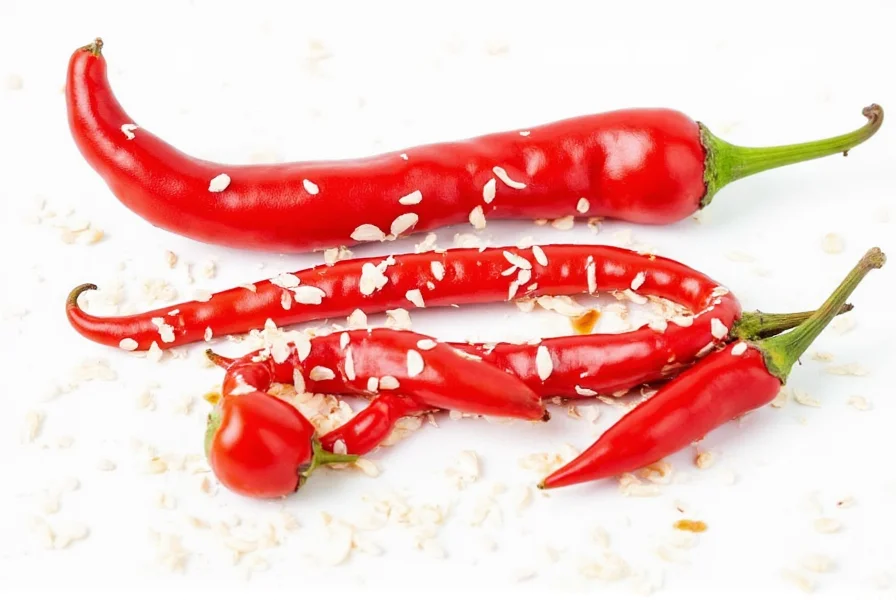Chilli hot peppers are a culinary powerhouse that transcends mere heat. They bring complex flavors, aromas, and health benefits to every dish. Whether you're a beginner or a seasoned cook, understanding these fiery ingredients can transform your cooking experience.
| Name | Heat Level (SHU) | Flavor Profile | Best For |
|---|---|---|---|
| Jalapeño | 2,500 – 8,000 | Mildly spicy, slightly fruity | Salsas, nachos, pickling |
| Serrano | 10,000 – 23,000 | Sharp, bright, grassy | Hot sauces, salsas, soups |
| Hatch Green | Varies by roast | Earthy, smoky, vegetal | Southwestern dishes, rellenos |
| Habanero | 100,000 – 350,000 | Fruity, floral, citrusy | Cayenne-style sauces, Caribbean cuisine |
| Ghost Pepper | ~1,000,000 | Intense heat with slight sweetness | Extreme spice challenges, commercial sauces |
| Scotch Bonnet | 100,000 – 350,000 | Tropical fruit, sharp heat | Jamaican jerk seasoning, island sauces |
The Scoville Heat Unit (SHU) scale measures capsaicin content, the compound responsible for spiciness. Here's a practical guide:
- 0–100 SHU: Bell peppers, mild paprika
- 100–2,500 SHU: Poblano, Anaheim
- 2,500–30,000 SHU: Jalapeño, Serrano
- 30,000–100,000 SHU: Thai bird's eye, Tabasco
- 100,000+ SHU: Habanero, Ghost Pepper, Carolina Reaper
- Wear gloves! Capsaicin is oily and sticks to skin — especially sensitive areas like eyes and nose. A pair of disposable gloves saves tears (literally).
- Use stainless steel tools. Plastic cutting boards and utensils tend to absorb oils, making cleanup tricky. Stainless steel is easier to wash clean.
- Roast or char for more flavor. Roasting adds a smoky depth that enhances any dish. Simply hold over a flame or broil until blistered.
- Remove seeds and membranes for less heat. That's where most of the capsaicin lives. Want milder heat? Scoop it out before chopping.
- Balance the burn with dairy or acid. Milk, yogurt, lime juice, or vinegar help neutralize the heat on your palate — keep these nearby when tasting hot dishes.
For Everyday Cooking
- Jalapeño: Mild heat with great versatility. Great in salsas, tacos, stuffed poppers, or pickled.
- Poblano: Rich, earthy flavor with medium heat. Perfect for chiles rellenos or adding depth to stews.
For Authentic International Flavors
- Thai Bird’s Eye: Tiny but mighty. Use in curries, stir-fries, and Asian-inspired marinades.
- Scotch Bonnet: Essential in Jamaican cuisine. Adds tropical heat and sweet notes to jerk sauces and grilled meats.
For Extreme Heat Lovers
- Ghost Pepper (Bhut Jolokia): Over a million SHU. Best used sparingly in sauces or for extreme spice challenges.
- Carolina Reaper: Currently holds the title for world's hottest pepper. Only for seasoned spice warriors.
How to Store Chillies
- Fresh: Store in a cool, dry place or refrigerate in a paper bag for up to two weeks.
- Dried: Hang in a well-ventilated area or store in an airtight container for months.
- Freezing: Flash freeze whole peppers — they'll retain flavor and can be grated or chopped directly from the freezer.
- Toasted whole chillies: Dry toast on a skillet to unlock deeper flavors. Perfect for mole sauces or spice rubs.
- Oil infusion: Make your own chili oil by steeping dried or fresh chillies in hot oil. Ideal for drizzling over noodles, rice, or pizza.
- Chili paste magic: Blend roasted or soaked chillies with garlic, salt, and vinegar for a powerful base to sauces, marinades, and dips.
- Layer the heat: Add chillies at different stages of cooking for layered flavor. Start with whole pods early on and finish with chopped fresh ones for brightness.
- Pair wisely: Balance heat with cooling ingredients like mint, coconut milk, or cucumber raita. Contrast is key to great flavor harmony.
Can eating too many chillies hurt you?
While it's nearly impossible to die from eating too much chili, consuming large quantities of extremely hot peppers can cause severe stomach pain, nausea, or temporary digestive issues. Moderation is key!
Why do some people get addicted to spicy food?
Capsaicin triggers the release of endorphins — the body's natural feel-good chemicals. Many people become hooked on the "spice high" it creates.
What if I touch a chili and then touch my face?
Wash your hands immediately with soap and water. If irritation occurs, apply milk or yogurt to soothe the burning sensation.
Are there non-spicy versions of common hot peppers?
Absolutely! Some cultivars have been bred specifically for milder heat while retaining flavor. Look for labeled 'mild' or 'sweet' versions of jalapeños, serranos, or habaneros.
How do I reduce spiciness if I added too much chilli to a dish?
Add dairy (like yogurt or cream), acidic elements (lemon juice or vinegar), or sweeteners (honey or sugar) to balance the heat. Serving with starchy sides like rice or bread also helps absorb capsaicin.
Are chilli peppers healthy?
Yes! They're rich in vitamin C, antioxidants, and capsaicin—which may boost metabolism and reduce inflammation. Just consume extreme-heat varieties in moderation to avoid digestive discomfort.
Can I grow chilli peppers at home?
Definitely! Most varieties thrive in containers with 6+ hours of sunlight. Start seeds indoors 8-10 weeks before last frost, and maintain consistent moisture. Harvest when peppers reach full color.
From everyday comfort food to international flair, chilli hot peppers offer endless possibilities in the kitchen. Whether you're a curious beginner or a seasoned spice lover, there's always more to explore with these versatile ingredients.
Remember: respect the heat, embrace the flavor, and don't be afraid to experiment. With the right knowledge and a few handy tricks, you can transform ordinary meals into extraordinary experiences — one pepper at a time.
So go ahead… add that extra slice of habanero, whip up a batch of homemade chili oil, or dare to try the ghost pepper. Your taste buds (and your inner chef) will thank you!











 浙公网安备
33010002000092号
浙公网安备
33010002000092号 浙B2-20120091-4
浙B2-20120091-4